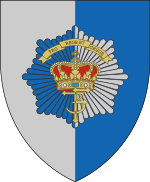This article needs additional citations for verification. (September 2018) |
You can help expand this article with text translated from the corresponding article in Danish. (June 2023) Click [show] for important translation instructions.
|
| The Royal Life Guard | |
|---|---|
| Den Kongelige Livgarde | |
 Coat of arms | |
| Active | 30 June 1658 – present (366 years, 4 months) |
| Country | |
| Branch | |
| Type | Foot Guards |
| Role | 1st Battalion – Mechanized infantry 2nd Battalion – Training Guards Company – Public Duties |
| Size | Three battalions & one company |
| Part of | Army Staff |
| Garrison/HQ | Høvelte Rosenborg Castle |
| Nickname(s) | Livgarden, Garden |
| Motto(s) | Pro Rege et Grege (For King and People) |
| Engagements | Northern Wars Scanian War Great Northern War Royal Life Guards' Mutiny Napoleonic Wars First War of Schleswig Second War of Schleswig Operation Weserübung War in Afghanistan (2001–2021) Post-invasion Iraq, 2003–2011 Operation Inherent Resolve Resolute Support Mission |
| Website | Official website |
| Commanders | |
| Current commander | Colonel Mads Rahbek |
| Chief of the Guard Company | Major H. C. Rørvang |
| Notable commanders | Duke William of Württemberg Christian X of Denmark Alexander III of Russia |
| Insignia | |
| Cap Badge of the Royal Danish Guard |  |
| Regimental belt | |
| Colours |  |
The Royal Life Guards (Danish: Den Kongelige Livgarde) is a mechanized infantry regiment of the Danish Army, founded in 1658 by King Frederik III. The primary task is to provide a number of soldiers from the Guard Company to serve as a guard/ceremonial unit to the Danish monarchy, while training the Royal Guards for various functions in the mobilisation force.[1] Until its disbandment, the Royal Horse Guards (Danish: Livgarden til Hest), served the role as the mounted guard/ceremonial unit, afterwards the role was taken over by Guard Hussar Regiment Mounted Squadron. During the time period 1684–1867, the Royal Life Guards were called The Royal Foot Guard (Danish: Den Kongelige Livgarde til Fods), in order to distinguish between the regiment and the Royal Horse Guards.[2]
- ^ Værnsfælles Forsvarskommando (11 September 2018). "Om Den Kongelige Livgarde". forsvaret.dk (in Danish). Danish Defence. Retrieved 28 September 2018.
- ^ Værnsfælles Forsvarskommando (18 December 2016). "Livgardens historie". forsvaret.dk (in Danish). Danish Defence. Retrieved 28 September 2018.